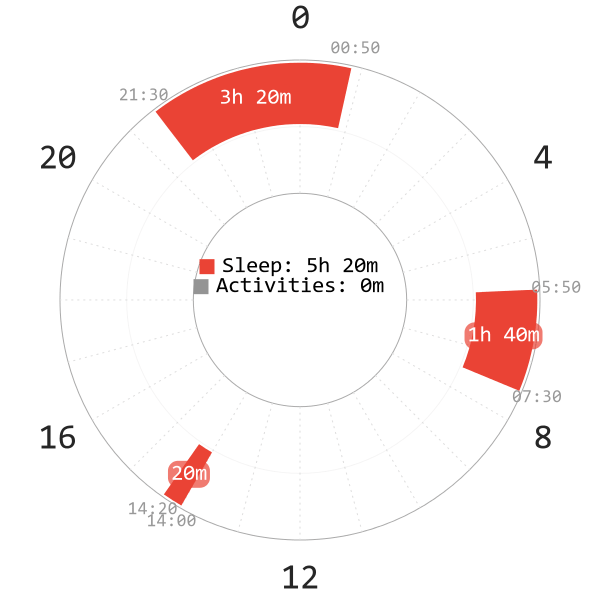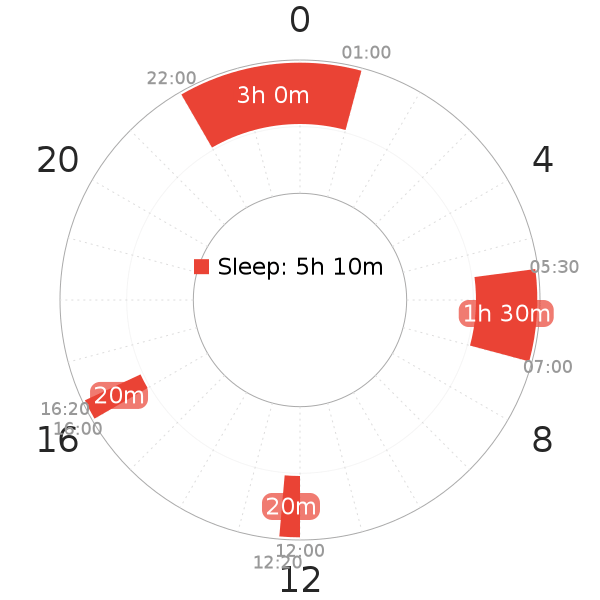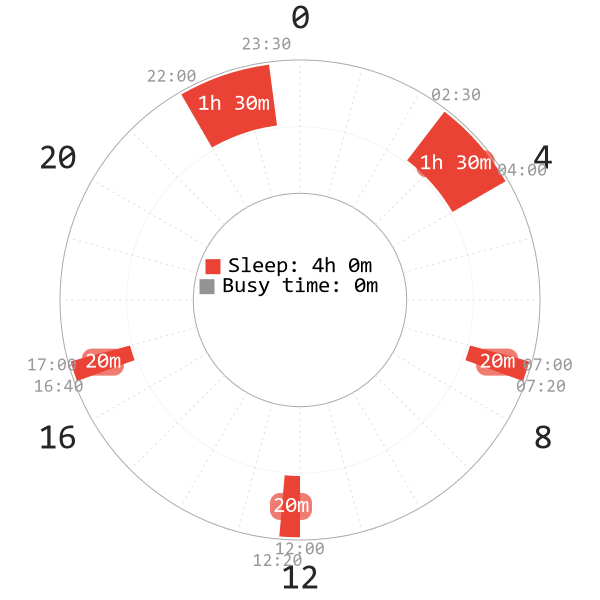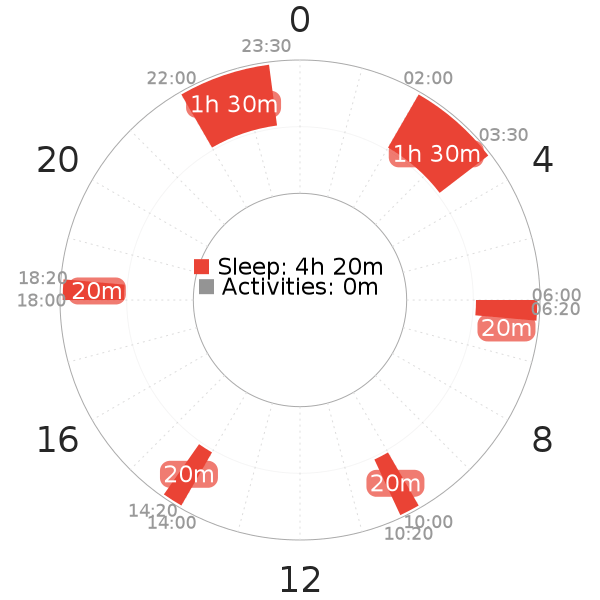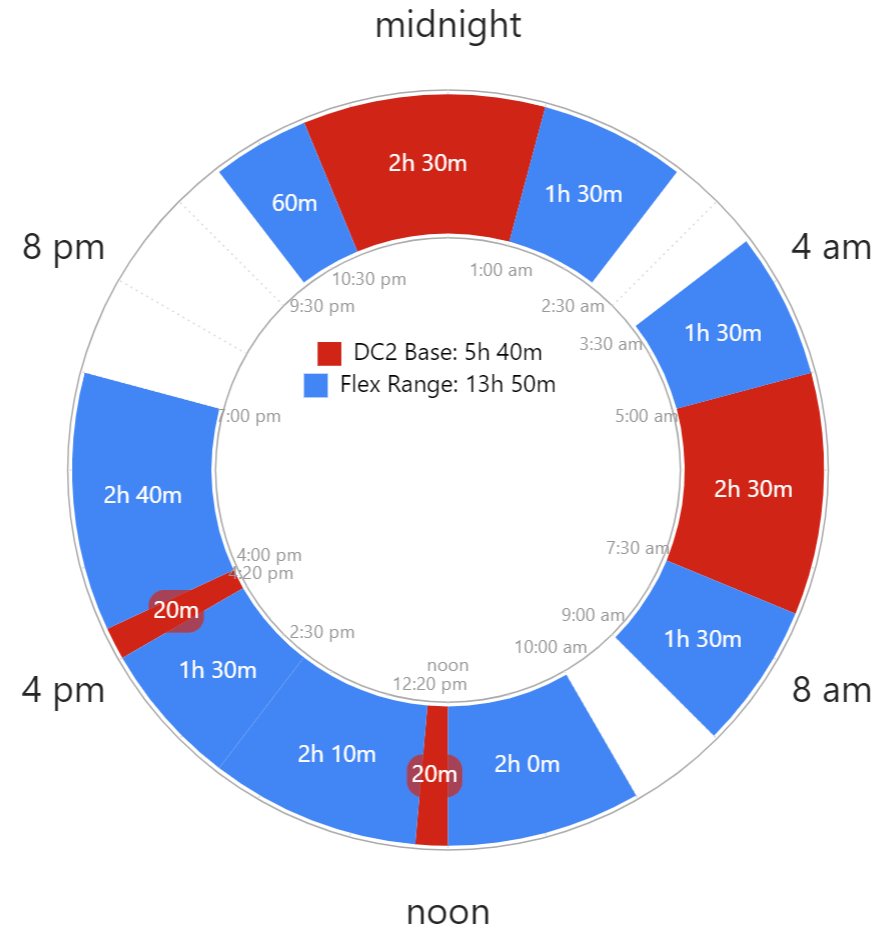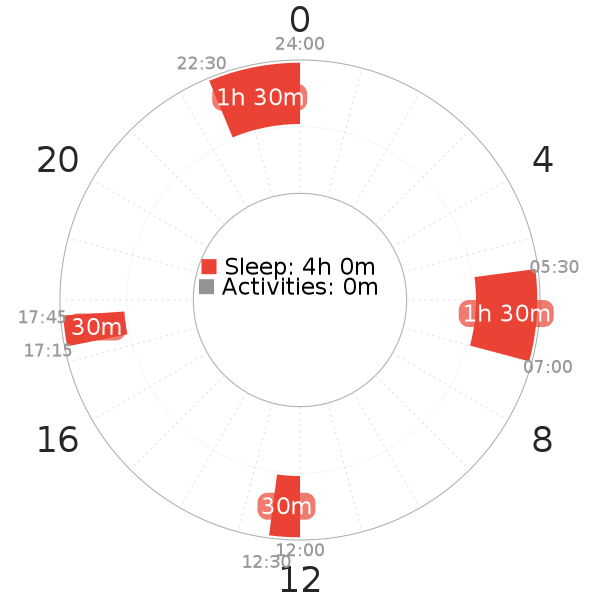DUAL CORE
Polyphasic Society originally proposed the Dual Core (DC) family of sleep schedules based on Segmented sleep.
- Instead of having a single long core, the core sleep splits into two smaller portions.
- SWS is dominant in the first core.
- REM sleep is a major sleep stage in the second core.
- The dual core schedules then distribute sleep into additional 20-minute daytime naps to alleviate REM sleep from the reduction in core sleep duration from Segmented sleep. These naps boost alertness and maintain a balance of homeostatic pressure.
Notes with Everyman schedules
It is typically more difficult to adapt to these schedules than to Everyman schedules; difficulties arise from shorter cores due to splitting and cycle compression.
- However, if one is naturally and regularly waking up during the night, there is a chance they are inclined toward dual core schedules. Dual core schedules could turn out to be the easier route for these people.
- During adaptation, it can be very hard to stay awake in the core gap.
- Similar to the Everyman line, extra tiredness persists until SOREM occurs in the naps. The Dual Core schedules are also not as well known as the Everyman schedules due to their lower popularity.
- The increased sleep quality that comes from segmenting the cores into the SWS and REM peaks allows for further sleep time reduction compared to single-core schedules.
Like with Everyman schedules, the naming of Dual Core schedules is based on how many naps it contains. For example, a Dual Core schedule containing 2 naps would be “Dual Core 2”, or DC2 for short.
Dual Core 1 (5 hrs 20 minutes)
- Invented by: Polyphasic Society
- Total sleep: 5 hours 20 minutes
- Classification: Dual Core schedule
- Specification: 2 core sleeps, 1 nap
- Mechanism: One core sleep around dusk, one core sleep around dawn and one nap around noon. Sleep stage division: First core with mostly SWS and second core mostly REM.
- Adaptation difficulty: Moderate
- Ideal scheduling: Dusk core around 21:00 to 22:00, dawn core is free to place till 07:00 or 08:00, REM nap around early afternoon.
Dual Core 2 (5 hrs 10 minutes)
- Invented by: Polyphasic Society
- Total sleep: 5 hours 10 minutes
- Classification: Dual Core schedule
- Specification: 2 core sleeps, 2 naps
- Mechanism: One core sleep around dusk, one core sleep around dawn, one nap around noon and one nap in the afternoon. Sleep stage division: First core SWS, second core REM.
- Adaptation difficulty: Somewhat hard
- Ideal scheduling: First core around 22:00, second core around 05:40, noon nap and afternoon nap.
Dual Core 3 (4 hours)
- Invented by: Polyphasic Society
- Total sleep: 4 hours
- Classification: Dual Core schedule
- Specification: 2 core sleeps, 3 naps
- Mechanism: One core sleep before midnight, one after midnight, dawn nap, noon nap, and afternoon nap. Sleep stage division: First core SWS, second core mixed, naps REM.
- Adaptation difficulty: Very Hard
- Ideal scheduling: 3-hour wake between 2 cores, dawn nap, noon nap and afternoon nap.
Dual Core 4 (4 hrs 20 minutes)
- Invented by: Tinytimrob
- Total sleep: 4 hours 20 minutes
- Classification: Uberman transitional schedule in a Dual Core style
- Specification: 2 core sleeps, 4 naps
- Mechanism: Transitional variant of DC3 with 4 naps that follows Uberman rhythm. One core sleep before midnight, one after midnight, dawn nap, mid-morning nap, mid-afternoon nap, and evening nap. Sleep stage division: First core SWS, second core mixed, naps REM.
- Adaptation difficulty: Very Hard
- Ideal scheduling: Sleeps are scheduled to start every 4 hours which resembles Uberman. Transition step to E5 or Uberman and also useful as a fallback from E5 or Uberman should adaptation fail. Generally inferior to DC3 unless keeping Uberman rhythm is useful (the extra nap leads to slower sleep onset). Cycle length on this schedule is likely to hit around 65m, so the second core might shorten to increase REM quantity in naps (although this is untested).
Dual Core As Much As You Like (DUCAMAYL)
- Proposed by: The Discord Polyphasic Community
- Total sleep: Undefined, but may average around 5.5-6.5 hours
- Classification: Flexible schedule, SPAMAYL variant, Dual Core variant
- Specification: 2 cores, multiple short naps
- Mechanism: Variant of SPAMAYL that includes 2 core sleeps. Evolves well from adaptation to DC1-extended, DC2-(extended) and DC3-extended. Then, adapt to flexible versions of these schedules as helpful intermediates. The first core sleep provides more SWS while the second core favors more REM. The nap(s) provide the remaining REM. The schedule relies on sensing tiredness patterns to get quality REM nap(s) and quality cores. You will need the freedom to take a nap soon at any time, and/or the ability to plan naps sensibly for each day. Ultimately, there should be no wake period too long that makes you tired.
- Adaptation difficulty: Hard
- Ideal scheduling: ~At least ~4.5-5h total sleep for both cores combined, with about 1-4 naps of 10-20 minutes in length. Nap spacing should take into account natural periods of tiredness, as well as the morning circadian peak. In the evening, 6-7 hour wake gaps are common, whereas alertness may wane after 3-4 hours awake around night/early morning hours. A longer Pronap of up to 45m might be plausible during early morning hours (6-10am) if all SWS has sufficed; this should be if one has adapted to the base strict schedule. The longer nap would allow longer wake periods and/or increased flexibility later in the day. The wake gap between 2 cores can increase or decrease depending on days. Each core might be flexible and/or varied max. 90m in length. It can be detrimental to add an extra cycle to a core more than once a week; this can destabilize adaptations to the reduced sleep total.
Bimaxion
- Invented by: GeneralNguyen
- Alternatively known as: Bimax, Quad, Quadphasic
- Total sleep: 4 hours
- Classification: Dymaxion transitional schedule in a Dual Core style
- Specification: 2 core sleeps of minimum length, 2 naps
- Mechanism: One core sleep before midnight, one around dawn, Dymaxion noon nap, and Dymaxion afternoon nap. Sleep stage division: Dusk core SWS, dawn core REM. Late nap can contain mixed sleep stages. More flexible than Dymaxion because there are 2 core sleeps to gain SWS and so 2 naps can be moved around to some extent.
- Adaptation difficulty: Very Hard
- Ideal scheduling: The whole schedule’s sleep distribution looks like Dymaxion, with one core before midnight, one core around dawn, one noon nap, one afternoon/evening nap.
Comparison between Dual Core Schedules
NOTE:
- The assessment table showcases differences between Dual Core schedules, based on standard scheduling.
- Unless specified otherwise, there are no mentions on extended versions.
- The table does not account for short sleepers; thus, these criteria will likely vary in them.
- Assessment denotations:
- 4/4: Positive, very high viability, or very easy
- 3/4: Somewhat decent viability, above average, or somewhat easy
- 2/4: Neutral, medium viability
- 1/4: Overall negative, low viability, below average, or difficult
| Criteria | DC1 | DC2 | DC3 | DC4 | DUCAMAYL | Bimaxion |
| Exercising | ||||||
| Time zone travel (> 5h) | ||||||
| Evening social time (18:00-23:00) | ||||||
| Daytime napping (07:00-17:30) | ||||||
| Schedule nap around meal time | ||||||
| Overall flexibility | ||||||
| Flexible core(s) | ||||||
| Hidden potential(s) | None | None | Extended | None | Varying nap duration, flexible night gap | None |
| Criteria | DC1 | DC2…….. |
| Exercise | ||
| Time zone travel (> 5h) | ||
| Evening social time (18:00-23:00) | ||
| Daytime napping (07:00-17:30) | ||
| Schedule nap around meal time | ||
| Overall flexibility | ||
| Flexible core(s) | ||
| Hidden potential | None | None |
| Criteria | DC3 | DC4…….. |
| Exercising | ||
| Time zone travel (> 5h) | ||
| Evening social time (18:00-23:00) | ||
| Daytime napping (07:00-17:30) | ||
| Schedule nap around meal time | ||
| Overall flexibility | ||
| Flexible core(s) | ||
| Hidden potential(s) | Extended | None |
| Criteria | DUCAMAYL | Bimaxion. |
| Exercise | ||
| Time zone travel (> 5h) | ||
| Evening social time (18:00-23:00) | ||
| Daytime napping (07:00-17:30) | ||
| Schedule nap around meal time | ||
| Overall flexibility | ||
| Flexible core(s) | ||
| Hidden potential | Varying nap duration, flexible night gap | None |
Brief analysis
- Most of the rules that apply to Everyman in terms of exercising, scheduling meals and long-term sustainability also apply to Dual Core.
- DC1 and DUCAMAYL have the strongest daytime napping viability because of having only 1 or very flexible daytime nap(s).
- Most DC schedules require certain sacrifices of social evening time. Dark period usually starts ~1.5-2h before the first core; this makes social evening time difficult to manage.
- Extended versions allow the first core to start later in the evening (e.g, 11 PM).
- Because of the stringent dark period management and an overall harder adaptation than Everyman, DC schedules have limited records of flexible core sleeps. This does not suggest in any way that both or one of the cores cannot become flexible.
- Some naps on certain DC schedules (especially extended versions) have high flexibility after adaptation. However, this does not apply to very low sleep totals like Bimaxion, DC3 and DC4.
- At least 4.5-5h of total sleep of both cores combined would be necessary for some flexibility of the schedule and adequate physical recovery from regular exercises.
- No DC schedules have less than 4h of sleep. This makes them at least on the borderline of adaptability.
- DC schedules have the advantage of offering a longer morning sleep. This allows for a lot of quality REM sleep and limits the number of daytime naps. However, this advantage only applies to mostly DC1, DC2, Bimaxion and DUCAMAYL.
- DUCAMAYL is not the only flexible DC schedule. Every other schedule can become flexible to some extent after adaptation. However, DUCAMAYL is a whole new adaptation altogether, with many changes in sleep structure.
Overall, DC1 and DC2 currently have the most amount of successful adaptations. The remaining DC schedules have very little success so far and are very difficult to adapt to.
Comparison between Dual Core & Everyman Schedules
See Everyman page.
Comparison between Dual Core & Tri Core Schedules
DC and Tri Core (TC) schedules share a common ground of having more than one core sleep. TC schedules have more fragmented core sleep structure. Thus, some differences and niches between them are noteworthy. The assessment denotations are the same as the table from the previous section.
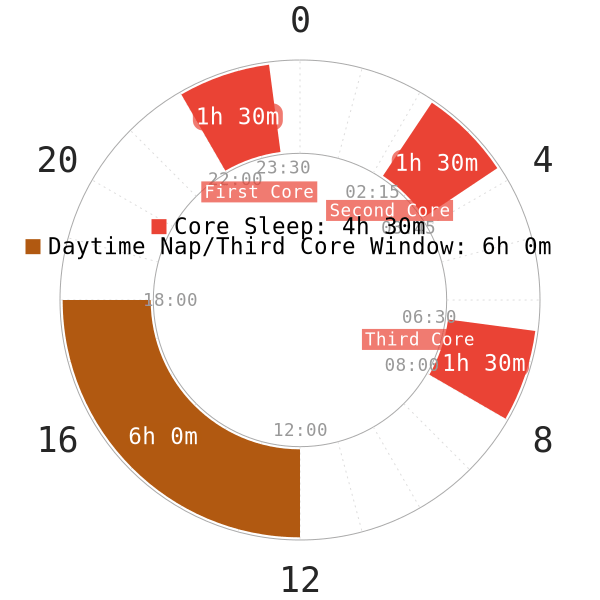
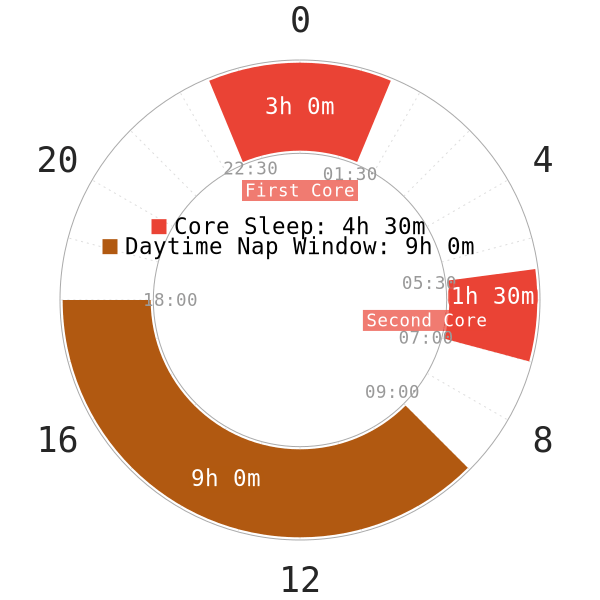
| Dual Core | Tri Core | |
| Transition from | Segmented sleep | Segmented sleep |
| Number of core sleep(s) | 2 | 3 |
| Number of naps | 1+ | 0-2 |
| Pronap application | No | No |
| Dusk sleep (21:00-24:00) | 1 core sleep | 1 core sleep |
| Dawn sleep (06:00-09:00) | 1 core sleep, 1 nap in the case of DC3 | 1 core sleep |
| Most commonly used core durations |
Dusk core: 4.5h, 3h, 3.3h Dawn core: 3h, 1.7h, 1.5h |
3h, 1.5h |
| Most flexible variation | DUCAMAYL | N/A |
| Night shift viability | ||
| Ease to have a dark period | ||
| Suitable for | Naturally segmented sleepers | Naturally segmented sleepers, heavy insomniacs |
| Adaptation difficulty | Overall somewhat more difficult than Triphasic-extended, but either than every other TC variants | Overall more difficult than DC schedules, bar DC3 and DC4 |
| Time zone traveling > 3h difference | ||
| Best suited for exercise | DC1-extended, DC2-extended, or DC2 | Triphasic-extended |
| Evening social time (18:00-23:00) | Only extended variants where dusk core can start at 23:00 | Only Triphasic-extended can afford a late core |
| Daytime social / work time (7:30-17:00) | Same as DC in the case of TC1, but overall more inconvenient than DC | |
| Flexibility | ||
| Flexible core | High potential (> 1h change in sleep time) in extended variants (> 5.5h TST) | Only Triphasic-extended so far has a decent chance. Regular Triphasic is very limited. |
| Hidden potential | Dawn core can make up for dusk core’s disruptions in sleep quality | Unknown |
| Dual Core | Tri Core | |
| Transition from | Segmented sleep | Segmented sleep |
| Number of core sleep(s) | 2 | 3 |
| Number of naps | 1+ | 0-2 |
| Pronap potential | No | No |
| Dusk sleep (21:00-24:00) | 1 core sleep | 1 core sleep |
| Dawn sleep (06:00-09:00) | 1 core sleep, 1 nap in the case of DC3 | 1 core sleep |
| Most used core durations | Dusk core: 4.5h, 3h, Dawn core: | 3h, 1.5h |
| Most flexible variation | DUCAMAYL | N/A |
| Night shift viability | ||
| Ease to have a dark period | ||
| Suitable for | Naturally segmented sleepers | Naturally segmented sleepers, heavy insomnia sufferers |
| Adapt. difficulty | Overall somewhat more difficult than Triphasic-extended, but either than every other TC variants | Overall more difficult than DC schedules, bar DC3 and DC4 |
| Time zone traveling > 3h difference | ||
| Best suited for exercise | DC1-ext, DC2-ext, or DC2 | Triphasic-extended |
| Evening social time (18:00-23:00) | Only ext. variants where dusk core can start at 23:00 | Only Triphasic-extended can afford a late core |
| Daytime social / work time (7:30-17:00) | Same as DC in the case of TC1, but overall worse than DC | |
| Flexibility | ||
| Flexible core | High potential (> 1h change in sleep time) in extended variants (> 5.5h TST) | Only Triphasic-extended so far has a decent chance. Regular Triphasic is very limited. |
| Hidden potential | Dawn core can make up for dusk core’s disruptions in sleep quality | Unknown |
Brief analysis
- The only Tri Core variant that would have strong long-term viability seems to be Triphasic-extended.
- Most TC schedules have the same weakness as DC schedules: the core sleep around SWS peak hours with limited evening social time.
- TC schedules overall give more sleep reduction than DC schedules, despite having 3 core sleeps.
- So far, DC schedules can become somewhat flexible after adaptation. However, there are very few records of flexible Tri Core schedules (bar Triphasic-extended). One adapted Triphasic sleeper (4.5h TST) only managed to move any of the core sleeps within 30m earlier or later than the original start time.
- TC may be more suitable for heavy insomniacs who cannot sleep for more than ~1-2h in a row. It may then be beneficial to wake up for some time at night before sleeping again; all sleep blocks are in smaller segments than those of DC (bar DC3/DC4).
- Because the design of TC patterns is based on the duration of a single sleep cycle, sleep blocks on each schedule follow the standard 90m cycle rule. There are very few records of alternate core durations from adapted sleepers.
- Because of more inconvenience in scheduling, TC patterns generally do not advocate for extended variants bar Triphasic-extended. This is because of the clumsiness to schedule all core sleeps around graveyard hours with any extended core.
In summary, TC schedules are very niched; DC schedules mostly outclass and outperform TC schedules in terms of adaptation success and scheduling.
Main author: Crimson & GeneralNguyen
Page last updated: 10 January 2021









